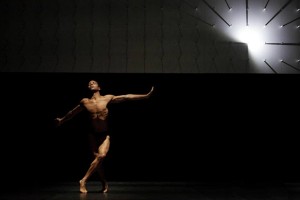FAR @ The Playhouse – Reviewed

C James Fagan was taken on a journey of discovery by FAR…
I’ll open with an admission. Until very recently I was unaware that this event was happening. It’s only through a stroke of good fortune I’m going! I don’t know what to expect; a quick glimpse at the copy on the website tells me that FAR is choreographed by Wayne McGregor who recently made Thom Yorke jerk around in the video for Flower.
Possibly more importantly, the piece is inspired by the Age of Reason, the time in the 18th century which saw a shift to a more rational expression of the world. Where a measured and intellectual explanation of the world will take precedence over the magics of chaos and superstition.
The teaser trailer also indicates that this might be a ‘big budget’ affair: a sensation compounded by the glossy flyer I pick up from the Playhouse’s foyer. There’s a sense of a blockbuster about this, the flyer echoes promotional material for Prometheus. It all adds to a sense of excitement, but should I temper this? So many things fail to live up to grand expectations.
I take my seat, and I realise I’m in a ‘proper’ theatre, not a performance space or an empty space turned over to a performer for the day – so often, it is the case that performance is relegated to venues that aren’t a natural fit. As I look at the shifting lights coming from behind the curtain I wonder how this will affect my reading of the piece.
I am about to find out. The room turns dark and the curtain goes up. We are greeted by figures holding flaming torches as an aria-like piece of music begins to float into the space. They form a circle around two figures who under the light of the flame, somehow appear to be bare and exposed, bringing to mind the figures on the Pioneer plaques.
They begin to move, they echo each other, approach each other with hesitating curiosity moving from a myriad of fluid movements. The torchbearers leave the stage one by one – it strikes me that this is a prelude and an indication that a time is passing, and in this case the fire of the medieval age is going out. To be replaced by what?
A lighting rack at the back of stage sparks into life, the music switches into something akin to Ligeti’s Atmospheres. The lights flash, spark, as if some kind of change was underway, the lighting rig gracefully rises. From the dimness behind, a single dancer emerges, followed shortly after by a burst of light. Suddenly the performer is dancing with a single nova, one shining light in the darkness. I can’t give a complete description of the dancer’s movements, but they bring to mind a sensation of exploration. As if his movements are an attempt to physically form an idea or to take an idea from the air which surrounds him.
From hereon-in it becomes difficult for me to describe the piece as a series of tableau as it changes with swift fluidity. The dancers appear to be moving to an unknown design, as individuals and part of a bigger whole. Each dancer seems to be working as part of a bigger organism, acting out some deeply written biological code. There’s a sequence where a trio of dancers are ‘attacked’ by single dancers until they form a ring, which in turn is disintegrated by a flash of light.
It’s akin to watching the internal biological workings of the body writ large. The world of blood, microorganisms and firing synapses played out in front of me, similar to the collaborations of Gina Czarnecki and Iona Keweny. Of course bodily allusions are apt – looking through the programme after the show, this piece was inspired by Roy Porters’ 18th century Flesh in the Age of Reason.

Within the performance, within the movements of the dancers, I can see this idea of how the exploration of the flesh, and the wider universe in which the flesh lives, has an effect on how we think about ourselves as humans. As we explored deeper physically into ourselves into our squishy innards it’s difficult to pinpoint where a consciousness might arise. This might not have occurred to me while watching the performance but it’s there within the graceful arch of the dancer’s limbs. It’s literally there in the sinews of their muscles.
By referencing the Age of Reason you might consider that the themes within the piece aren’t relevant. I would argue otherwise; we continue to live in a time where our knowledge is continually expanding. Technology and information affect our day to day lives in ways people in the 18th century could barely imagine.
FAR gives a sense that the valuation of what it means to be human is still relevant, maybe more so in a world where we begin to shape technologies which mirror us: while watching, I was reminded of the final chapter of William Gibson and Bruce Sterling’s novel The Difference Engine which provides a vision of a world where people are merely digitized pieces of data.
I’ve gone off on a tangent perhaps, but it’s testament to how involved I felt in the piece. I don’t want to give the impression that FAR is a dry piece of research. Throughout there are moments of beauty, including a sequence where the dancers silhouetted against the light begin to merge into each other. And the dancers are great throughout – their movements feel spontaneous, alive they move with purpose – it’s genuinely exciting to watch. I can’t end without mentioning the lighting, which is integrated into the piece and feels like another member of the troupe.
I was swept up by FAR, by its deft use of music, technology and the human.
C James Fagan
All images courtesy Ravi Deepres





